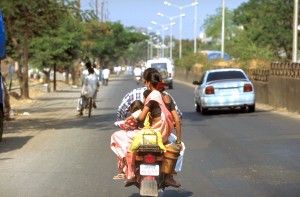By Smriti Gopal
When dangerous drivers drive into police officers directing road traffic and pedestrians, this scenario probably causes fear in the community of the country. Some people believe that India has the deadliest roads in the world. In some situations, driving licences can be bought easily and sometimes police officers accept bribes in order to return the driving licences to drivers. But on a brighter note, the UN plans to reduce road deaths by 50% by 2020 and hopefully other countries will follow suit.
It’s thought that India’s Prime Minister, Narendra Modi hopes to tame all vehicles, bicycles and animals that travel on the roads in India. In India, it is not unusual to see camels, elephants and cows travelling on the roads, with the traffic. Transport Minister, Nitin Gadkari seems to have a similar thought as Modi. Gadkari said: “Providing safe, efficient, cost-effective and faster transport across the country is our mission.”
It looks like the joint commissioner of police for traffic in Mumbai, B.K. Upadhayay and Indian Foundation of Transport Research and Training, Senior fellow, S.P. Singh agree with the ministers, about the road traffic. Upadhayay said: “The government needs to enforce heavy penalties for traffic violations. Getting a driver’s license also needs to be more difficult.” Singh said: “Traffic fines are often fixed with a bribe.”
 Earlier this year in February 2015, the World Resources Institute (WRI) estimated that 17-18% of road traffic fatalities occur in urban areas. According to the WRI, pedestrians and cyclists accounted for 63% of fatalities in Delhi in contrast to 11.4% of fatalities in the country as a whole.
Earlier this year in February 2015, the World Resources Institute (WRI) estimated that 17-18% of road traffic fatalities occur in urban areas. According to the WRI, pedestrians and cyclists accounted for 63% of fatalities in Delhi in contrast to 11.4% of fatalities in the country as a whole.
In order to save approximately 200,000 lives over five years, Gadkari aims to use important strategies for the road traffic. One of these strategies is, if the driver ends up killing a child, the driver will face a £3,000 fine and any repeat offenders will lose their license. Another strategy is that the driver will face penalties for speeding, drink-driving and failing to stop at red lights.
Sometimes people probably feel that taxi drivers race through the roads. Gurgaon’s Sales Executive, Ashutosh Bhardwaj said: “[Taxi drivers] are the real menace. They are racing their cars not driving them in a proper, sober fashion.” It’s claimed that the poor feel that they suffered the most when they travel on vulnerable bicycles/motorbikes or when they travel on overcrowded or badly maintained buses. However, if school bus drivers go over the limit, they will face three years in jail according to a recent report in The Guardian online.
World Health Organisation (WHO), Director General, Margaret Chan said: “Road traffic crashes are a public health and development crisis. Every day, road traffic crashes claim nearly 3,500 lives and injure many thousands more. The vast majority of those affected are young people in developing countries.”
So to work towards preventing a loss of lives in developing countries such as India, the WRI talks about the international road safety discourse focusing on reducing the average speed of vehicles. While doing this, one thing probably needs to be kept in mind; reducing the risk of fatality per kilometre travelled.
The reasons for road traffic fatalities are probably endless. A couple of possible reasons are, traffic-law enforcement and drivers are sometimes not trained and the roads are sometimes poorly designed. No wonder the rate of fatalities are increasing. It’s claimed that presently, one person dies on India’s roads every five minutes but by 2020 this figure is projected to rise to one every three minutes.





















